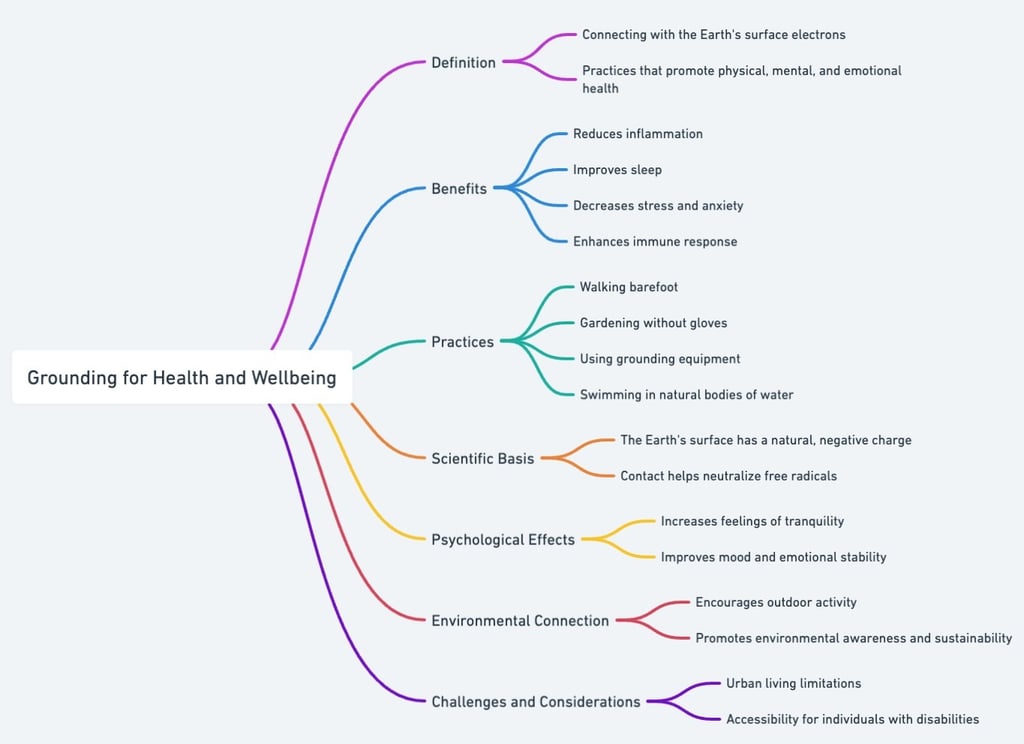
A Guide to Grounding for Health and Wellbeing
Bruce Gibson ND
5 min read


A Guide to Grounding for Health and Wellbeing
By Bruce Gibson ND
Grounding, also known as earthing, is a therapeutic technique that involves activities that reconnect individuals to the Earth's surface electrons.
The premise is simple yet profound: direct contact with the ground can have various health benefits, ranging from inflammation reduction to improved sleep and mental health. This article delves into the concept of grounding, exploring its benefits, practices, scientific basis, psychological effects, and its connection to environmental awareness.
Definition
Grounding refers to direct skin contact with the surface of the Earth, such as walking barefoot or lying on the ground. This connection allows for the transfer of the Earth's electrons to the body, promoting physiological and psychological health benefits. The practice is rooted in the understanding that the Earth's surface maintains a negative charge, capable of neutralizing free radicals in the body (Chevalier et al., 2012).
Benefits of regular grounding.
Reduces Inflammation
Research has shown that grounding can significantly reduce inflammation in the body. A study by Oschman et al. (2015) demonstrated that individuals who practiced grounding had measurable reductions in inflammatory markers compared to those who did not.
Improves Sleep
Grounding has been linked to improved sleep patterns. A study published in the Journal of Alternative and Complementary Medicine found that participants who used grounding sheets reported increased sleep quality and reduced nighttime awakenings (Ghaly & Teplitz, 2004).
Decreases Stress and Anxiety
The act of grounding has been found to decrease levels of stress and anxiety. A pilot study by Chevalier and Sinatra (2011) showed a reduction in cortisol levels, the body's main stress hormone, after periods of grounding.
Enhances Immune Response
Grounding may also enhance the immune response, as evidenced by faster recovery from disease or injury, likely due to its anti-inflammatory effects (Oschman et al., 2015).
Common Earthing Practices
Grounding can be achieved through simple practices:
Walking Barefoot: The most straightforward method, walking barefoot on grass, soil, or sand, allows for direct electron transfer.
Gardening Without Gloves: Engaging in gardening activities without gloves can serve as an effective grounding practice.
Using Grounding Equipment: For those unable to access natural surfaces, grounding mats, sheets, and other devices can simulate the effects of earthing.
Swimming in Natural Bodies of Water: Lakes, rivers, and oceans are conductive environments for grounding.
Scientific Basis
The scientific basis for grounding lies in the Earth's natural, negative charge. Contact with the ground helps neutralize free radicals in the body, which are positively charged molecules known to contribute to inflammation and disease (Chevalier et al., 2012). The Earth maintains a negative electrical potential on its surface, and when you make direct contact with it, your body becomes equalized to the Earth's energy. This concept, while simple, has profound implications for health as explored through various scientific lenses.
Electrical and Biochemical Foundations
The human body is fundamentally bioelectrical. Our cells transmit multiple electrical impulses for everything from muscle contractions to nerve impulses and the regulation of the heart's rhythm. The Earth's surface is rich in free electrons due to the global atmospheric electrical circuit, constantly replenished by solar radiation, lightning, and heat from the Earth's core. When the skin comes in direct contact with the ground, the body absorbs these electrons, which are nature's most potent antioxidants, neutralizing positively charged free radicals that can cause inflammation and disease (Oschman, Chevalier, & Brown, 2015).
Neutralising Free Radicals
Free radicals are molecules with unpaired electrons, making them highly reactive and prone to participating in destructive chemical reactions. They can damage cells, proteins, and DNA by stealing electrons through a process called oxidation. The electrons received through grounding effectively neutralize free radicals by providing the missing electrons, thus stopping the oxidative chain reactions and reducing inflammation (Chevalier et al., 2012).
Reducing Inflammation
Inflammation is a biological response to harmful stimuli, such as pathogens, damaged cells, or irritants. Chronic inflammation is linked to numerous diseases, including heart disease, diabetes, arthritis, and Alzheimer's disease. Grounding has been shown to reduce chronic inflammation by decreasing the production of inflammatory cytokines and increasing the number of anti-inflammatory cytokines, as demonstrated in various studies (Oschman et al., 2015).
Improving Sleep, Pain, and Cortisol Levels
The circadian rhythm, our body's natural 24-hour clock, regulates sleep patterns, hormone production, and other physiological processes. Grounding can influence the circadian rhythm by normalizing the day-night cortisol rhythm, which in turn improves sleep, reduces pain, and helps manage stress. A study by Ghaly and Teplitz (2004) found that participants who slept on grounding sheets experienced significant improvements in sleep and reduced nighttime levels of cortisol, leading to greater emotional stability and stress reduction.
Enhancing Immune Response
The immune system's efficiency is partly dependent on the balance of pro-inflammatory and anti-inflammatory cytokines. Grounding's effect on reducing inflammation can support the immune system, making it more efficient at fighting infections and healing wounds. The electron transfer may also stimulate the production of red and white blood cells, further enhancing immune function (Chevalier & Sinatra, 2011).
Cardiovascular Health
Grounding may have beneficial effects on cardiovascular health by improving blood flow and viscosity. A study published in the Journal of Alternative and Complementary Medicine demonstrated that grounding could reduce blood viscosity, a significant factor in cardiovascular disease, by improving the zeta potential of red blood cells, enhancing their electrical charge, and thus reducing clumping (Chevalier et al., 2013).
Psychological Effects
Grounding also has significant psychological benefits, including increased feelings of tranquility and improved mood and emotional stability. These effects are thought to be linked to the reduction in stress hormones and the promotion of a calm state of mind.
Environmental Connection
Beyond personal health benefits, grounding encourages outdoor activity and fosters a deeper connection with the environment. This connection can lead to increased environmental awareness and a greater inclination towards sustainability practices.
Challenges and Considerations
Despite its benefits, grounding faces challenges, particularly in urban settings where natural surfaces are less accessible. Additionally, individuals with disabilities may find it difficult to engage in grounding practices. These challenges highlight the need for innovative solutions, such as grounding equipment, to make earthing more accessible.
Conclusion
Grounding or earthing presents a simple yet effective way to enhance physical, mental, and emotional wellbeing. By reconnecting with the Earth's surface, individuals can tap into a natural source of healing and tranquility. While more research is needed to fully understand all the mechanisms behind grounding, the existing evidence supports its inclusion in a holistic approach to health. As society continues to grapple with the stresses of modern life, grounding offers a pathway back to nature, promoting not only personal health but also a deeper respect for the environment.
References
Chevalier, G., et al. (2012). Earthing: Health Implications of Reconnecting the Human Body to the Earth's Surface Electrons. Journal of Environmental and Public Health.
Ghaly, M., & Teplitz, D. (2004). The biologic effects of grounding the human body during sleep as measured by cortisol levels and subjective reporting of sleep, pain, and stress. Journal of Alternative and Complementary Medicine.
Oschman, J. L., Chevalier, G., & Brown, R. (2015). The effects of grounding (earthing) on inflammation, the immune response, wound healing, and prevention and treatment of chronic inflammatory and autoimmune diseases. Journal of Inflammation Research.
Chevalier, G., & Sinatra, S. T. (2011). Emotional stress, heart rate variability, grounding, and improved autonomic tone: clinical applications. Integrative Medicine: A Clinician's Journal.
This overview underscores the potential of grounding as a valuable addition to wellness and health practices, offering a natural and accessible way to enhance overall wellbeing.
Thank you for reading!
Kindly, Bruce Gibson, Australian Herbalist & Naturopath
* The Author Bruce Gibson ND, will be publishing a comprehensive series of Articles here, and is currently developing an Online Course on Wholistic Welnness & Naturopathy - stay tuned!
Let's talk about it...

